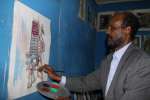Refugees Magazine Issue 105 (Life in a refugee camp) - A camp is born
Refugees Magazine, 1 September 1996
Despite careful planning, some refugee camps spring up seemingly on their own, influenced by many factors, including geography, economics, political and security concerns and – last but not least – sheer necessity and desperation.
Some refugee camps are carefully planned and some spring up seemingly on their own. Their location can be determined by myriad factors, including geography, geology, economics, political and security concerns, resources and – last but not least – sheer necessity and desperation.
In Hartisheik's case, market economics and clan tradition played a crucial role. A stroll through its refugee-run central market illustrates the importance of this grassroots commercialism even today – eight years after the founding of what became one of the world's largest camps.
You can find almost anything you need at the Hartisheik market: imported clothes; jogging shoes; radios and televisions; auto spare parts and the ubiquitous khat – a stimulant from the Catha Edulis plant that grows abundantly in the nearby fields.
Most of the goods are smuggled into Hartisheik, primarily from the Somali ports of Berbera and Bossaso. They are bought by bargain hunters on either side of the Ethiopia-Somalia border. Buyers from the Ethiopian side come as far away as the capital, Addis Ababa, a day-long trip overland.
The market – a motley collection of mud and corrugated-tin huts lining windswept streets that are muddy during the rainy season and dusty and dry the rest of the year – lies at the very centre of Hartisheik and of the lives of its residents.
Refugee Somali merchants and traders from Hargeisa began building the market in May 1988. Carrying their merchandise with them, they fled the fighting when the Siad Barre regime in Mogadishu sent warplanes to put down a clan uprising in Hargeisa, Somalia's second largest city.
The refugees first went to Harshin, an Ethiopian village about 25 kms from the Somali border. UNHCR deployed its staff there to care for the arrivals, including Ethiopian refugees in Somalia who had fled the Mengistu regime in Ethiopia in the 1980s. When Harshin was full, UNHCR looked for a larger camp with available water. But the government refused to grant the required space further inland, where there was adequate water. It still harboured suspicions against the Somalis against whom it had gone to war for control of the disputed Ogaden region in eastern Ethiopia in the 1970s.
The Ethiopian government decided to settle the refugees at Hartisheik, 50 kms east of Harshin. But even before UNHCR could evacuate the refugees at Harshin, thousands of Somalis – many of them women and children – had begun settling at Hartisheik.
International conventions, particularly those followed in member states of the Organization of African Unity, call for the establishment of refugee camps within a reasonable distance – usually interpreted to mean about 50 kms – from the border, for security reasons. But these standards cannot always be followed.
In early 1994 in central Africa, for example, UNHCR sent emergency teams to look into suitable sites in four neighbouring counties when it became apparent that the civil war in Rwanda could produce large numbers of refugees. But when the Rwandan refugees came in overwhelming numbers, circumstances forced UNHCR to build camps close to the border. In Zaire's volcanic, eastern region, there was practically no space to settle 1 million Rwandan refugees. Despite tremendous obstacles, UNHCR was able to give, with donor support, an acceptable level of assistance to the Rwandan refugees, at least at the outset, before funding problems came up this year.
The decision by the refugees to settle at Hartisheik was in part influenced by clan traditions and practice. Although they speak a single language and share the Moslem religion, Somalis are divided into numerous clans. Political and geographic divisions mean nothing to them. Mostly nomadic, they take their herd where there's water, within the clan territory where they feel safe. They call it "following the cloud."
The refugees at Hartisheik belong to the Issack clan, whose territory covers parts of both Somalia and Ethiopia, including Hartisheik. Clan members include both Ethiopians and Somalis. They help one another, according to clan custom. Thus, the Hartisheik refugees are relatively comfortable in their surroundings. For them Hartisheik is home, as Hargeisa was. Unlike most Somalis, who are nomadic, the Hartisheik refugees were city dwellers in Hargeisa and other urban centres in north-west Somalia. As former shop owners, traders and labourers, the market at Hartisheik offers them employment and other opportunities that they cannot find today in Hargeisa.
In 1988, Hartisheik was just a small village of four or five huts. The villagers raised goats and camels. There was little vegetation in the surrounding grassy plains and only one water well before refugees swarmed into the area over a three-month period beginning in May. Many of the arrivals were wounded, hungry and exhausted from the long trek. "People were dying like flies," recalled Ali Gulaid, a Somali-American from Houston, Texas, who went to Hartisheik to look for his parents. "That was the most depressing thing I saw in my life."
As many as 400,000 people – Somalis and Ethiopians – were estimated to have received aid at Hartisheik alone during the emergency. It was difficult to distinguish between refugees, returnees and locals – all of them were in dire straits. Later, in 1991, an official census put the number of Somali refugees at Hartisheik at 220,000.
UNHCR moved into the camp as the refugees flooded in. Its staff planned and coordinated programmes implemented by non-governmental organizations (NGOs). These activities included organizing shelter, health and sanitation services, food distribution and setting up water facilities. Because the region was semi-arid, the first priority was to look for water. Permission had to be secured from the government to truck water from Jijiga, 60 kms away. It was granted on condition UNHCR keep the dirt road in shape. Then 35 water depots, including nine bladders, and 978 taps were installed. Eight tankers brought water daily from Jijiga. The water source later shifted to newly drilled boreholes at Jerrer valley to avoid depletion of Jijiga's water supply and increase the cost effectiveness of tanker operations.
UNHCR site planners came and plastic sheeting was distributed. But the refugees set up their usually mobile huts wherever they thought it was convenient. Organizing them was a tough job. Constructing buildings also proved difficult because of lack of water; pre-fabricated materials had to be brought in, along with heavy equipment. Two hospitals and two schools were built in 1991.
UNHCR's main implementing partners were Save the Children Fund (U.K.), which was in charge of feeding programmes for children and mothers; CARE, which trucked water and maintained roads; Oxfam, which built the water storage systems and pipes; Handicap International, which took care of invalids; and the government Administration for Refugee and Returnee Affairs (ARRA), which was responsible for overall camp management, including food distribution, education and health.
Source: Refugees Magazine Issue 105 (1996)



































